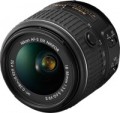Viewing angles
This parameter determines the size of the area of the scene being shot that falls into the frame. The wider the viewing angles, the larger the area the lens can capture in one shot. They are directly related to the focal length of the lens (see "Focal length"), and also depend on the size of the specific matrix with which the optics are used: for the same lens, the smaller the matrix, the smaller the viewing angles, and vice versa. On our website, in the characteristics of optics, viewing angles are usually indicated when used with the matrix for which the lens was originally designed (for more details, see "Matrix Size").
Autofocus drive
A type of drive that ensures the movement of lens structural elements during automatic focus. Currently, the following types can be used:
—
Ultrasonic motor. The most advanced type of drive to date. Ultrasonic motors are much faster than conventional motors, provide higher accuracy, consume less power and are virtually silent. However, their cost is quite high.
—
Stepper motor. Drive control focal length and zoom (zoom). This type of motor is used for the most part only in full-size digital cameras. Among the advantages of a stepper motor, one can note: high reliability and accuracy of operation; in addition, it does not require power supply to maintain focus and zoom. Of course, stepper motors are not without drawbacks. Among the minuses can be identified: slow speed and increased noise. Additionally, a stepper motor is characterized by large dimensions and a rather large weight, which physically does not allow this type of drive to be integrated into the optics of mobile phones and ultra-compact cameras.
— Motor. In this case, an electric
motor of a traditional design is meant. Such drives are simple and, as a result, inexpensive. Their disadvantages are the relatively low speed of operation, as well as the noise produced during this; the latter can sometimes be critical — for example, when shooting wildlife. Recently, designers have been us
...ing various tricks to neutralize these shortcomings, but in general, the characteristics of conventional motors still remain relatively modest.
— Is absent. The complete absence of an autofocus motor in the lens. Focus such optics can be carried out either by the “screwdriver” system, or strictly manually (for more details on both options, see below).Image stabilization
The presence in the lens of its own
image stabilization system. Such a system includes gyroscopes and movable lenses that compensate for small tremors of the lens and prevent the appearance of “shake”. Stabilization is especially relevant when shooting handheld, especially at slow shutter speeds and/or at long distances with high magnification: it is in such conditions that “shake” affects the quality of the image the most. At the same time, it should be taken into account that the presence of a stabilizer significantly affects the weight, dimensions and, above all, the price of optics; at the same time, some modern cameras have their own stabilization systems (due to matrix shift). Therefore, it makes sense to choose a lens with this function in the case when maximum protection against “shake” is of fundamental importance.
Design (elements/groups)
The number of elements (in fact, the number of lenses) included in the design of the lens, as well as the number of groups in which these elements are combined. Usually, the more elements provided in the design, the better the lens handles with distortions (aberrations) when light passes through it. On the other hand, numerous lenses increases the dimensions and weight of the optics, reduces light transmission (for more details, see "Aperture") and also puts forward increased requirements for the quality of processing, which affects the cost of the lens.

